Solutions
We build scalable and secure RFID solutions that connect industrial assets to collect and analyse data and deliver real-time insights for optimising industrial infrastructure and operations. We assist in accelerating Digital Transformation and can do so without the need to be connected to the Internet 24/24, by using patented technology.
To understand the typical technical approach to the track and trace paradigm we provide you with brief overview of the different technologies.
RFID or GPS
Active UHF RFID technology is different from other types of RFID because it uses a battery as an internal power source. This type of RFID technology operates on the UHF band on the RF spectrum usually at or around 433 MHz or 900 MHz. Active RFID systems have a typical read range of over 100 meters and are used in applications such as remote monitoring, IT asset management, and auto manufacturing.
Active RFID tags send ‘beacons’ or signals to a reader at predetermined time intervals, which are dependent on the exact frequency and programming of the tag (usually every 3 – 5 seconds). These tags can store large amounts of data and are available in specific formats for rugged applications.
An Introduction to GPS
Global Positioning System (GPS) is a U.S. owned technology that helps locate and track GPS-enabled devices and tags by using satellites. According to the U.S. government, all satellites fall into three segments: the space segment, the control segment, and the user segment. The user segment controls satellites used for signaling GPS receivers and other satellites for 3D positioning.
From space, GPS satellites broadcast their exact location, status, and time and the signal is picked up by GPS devices on Earth. The exact time that the device receives the signal is documented and used to calculate the distance between the GPS device and the satellite.
The GPS device on Earth picks up at least four different satellite signals, calculates its distance from each one, and then uses an algorithm to determine its exact location.

Combining GPS & Active RFID
Many times when people think of GPS technology, they typically think of the GPS devices in their cars or phones; but, asset tracking with GPS technology is becoming much more prevalent. GPS tags or receivers are now available for applications including and similar to large asset tracking of cargo and shipping containers or machinery.
Active RFID cannot provide the extreme read range that GPS tags can provide, but it works well for applications that involve tracking items in a fixed area such as a laydown yard or across multiple warehouses.
GPS and RFID technologies have been combined in the past. Together these two technologies allow companies the enhanced visibility that comes from GPS as well as the specific identification techniques that come from RFID. In order to track assets, both technologies require software to produce expected results. To see the two technologies compared side by side, reference the chart above.
Active RFID tags with embedded GPS receivers can provide GPS location coordinates as part of their normal beacon payload. This tag type can either be read through an active RFID reader or through a beacon directly to a satellite. The signals can then be received by a satellite base station where a software application can query to obtain the location information.
IoT
“It’s about networks, it’s about assets, it’s about data, so it’s our business”
IoT vs RFID

IoT allows devices on closed private internet connections to communicate with others and “the Internet of Things brings those networks together. It gives the opportunity for devices to communicate not only within close silos but across different networking types and creates a much more connected world.”
The Internet of Things (IoT) is enabling Digital Transformation across nearly every vertical, providing enterprises with insights into their business that they’ve never had before. Industrial IoT will change the way that humans, machinery, and computer systems interact, fostering a new era of economic growth.
IoT applications help industrials run their assets more efficiently and also make people more efficient, arming them with the right information to make more informed decisions.
Request for password protected Testimonials on our site please contact us
 Weapons Tracking
Weapons Tracking 
